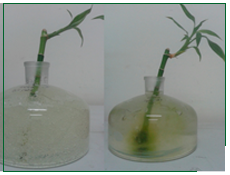PHYTOTOXICITY AND TOXICITY
Superabsorbent polymers based on polyacrylates have no systematic toxicity (LD50 for rats> 5000 mg / kg) and are low risk for ingestion, inhalation and skin contact. It also does not offer phytotoxicity to plants and animals, which is evidenced in a study of germination of lettuce seeds, algae growth and feeding of larvae and insects. Polyacrylate SAPs are approved for use as soil conditioners by various environmental agencies such as the EPA (USA), the US Department of Agriculture and almost all countries in the world.
1) Phytotoxicity with Lactuca sativa
In a standard phytotoxicity test carried out with lettuce seeds (Lactuca sativa) in a hydrogel produced with HIDROSILO at 10g / L has showed a germination rate greater than 95%, equivalent to the germination rate obtained when only water is employed.
*Germination of lettuce seeds (Lactuca sativa) in HIDROSILO hydrogel

_____________________________________________________________________________________________________________________________________________________________________________
2) Phytotoxicity with Chlorellas algae
The growth rate of Chlorellas algae in hydrogel containing 10 g/L of HIDROSILO was higher than the growth rates obtained in pure water, mainly due to the presence of biodegradable organic matter used by the algae and the presence of nitrogen and potassium as macronutrients.
*Growth of chlorellas algae in HIDROSILO hydrogel after 30 days of inoculation

_____________________________________________________________________________________________________________________________________________________________________________
3) Toxicity with Tenebrio molitor
Larvae of the Tenebrio molitor beetle and adult insects fed with wheat bran and oats containing 20% hydrogel with 20g / L of HIDROSILO, were monitored for 3 successive generations and the observed mortality rate values were statistically similar to that of larvae and beetles fed with the same cereals and water at 20%, staying between 90% and 95%.
*Tenebrio molitor larvae fed with HIDROSILO hydrogel

_____________________________________________________________________________________________________________________________________________________________________________
4) Drosophila toxicity
Drosophila fly eggs that were placed in the HIDROSILO hydrogel in the rate of 20 g / L and sucrose at 50 g / L were shown to have a viability rate greater than 93% for transformation into larvae. The larvae obtained in these conditions transformed into pupae showed viability of transformation in adult flies of practically 100%.
*Larva of Drosophila fly under development in HIDROSILO gel

_____________________________________________________________________________________________________________________________________________________________________________
5) Growth of Dracaena sanderiana
Dracaena sanderiana or Lucky Bamboo showed growth in HIDROSILO hydrogel at 10 g / L equivalent to that compared to its cultivation in water only. In this test the plant was monitored for 18 months and the same amount of water lost monthly through evaporation and transpiration by the plant was being replaced in the pot.
*Growth of the Lucky Bamboo (Dracaena sanderiana) in HIDROSILO hydrogel at 10 g / L

_____________________________________________________________________________________________________________________________________________________________________________